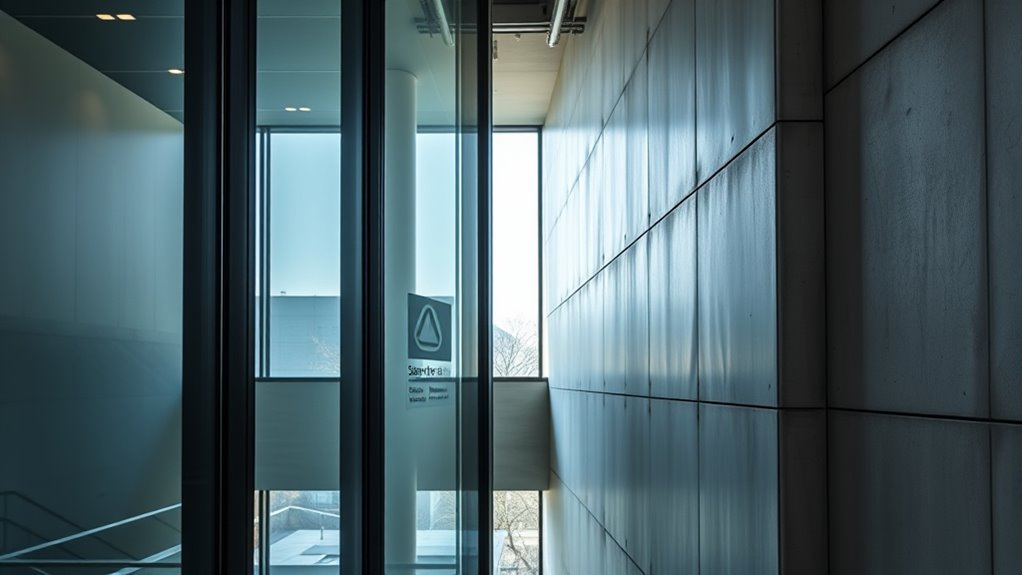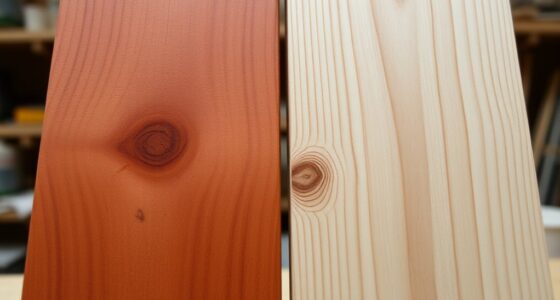When comparing glass and solid walls, you need to follow strict building codes for safety, fire resistance, and structural integrity. Glass must be impact-resistant, often tempered or laminated, and properly installed to meet impact and safety standards. Solid walls should provide adequate fire protection and load support. Ensuring accessibility, environmental compliance, and ongoing maintenance is essential. To keep your project safe and compliant, understanding these standards is key—keep exploring to learn more about maintaining safety and regulation adherence.
Key Takeaways
- Glass walls require safety glass, impact resistance, and proper installation to meet building code safety standards.
- Solid walls must meet load-bearing, fire resistance, and structural integrity requirements for compliance.
- Both wall types need regular inspections, certifications, and adherence to fire, safety, and accessibility codes.
- Transparency and accessibility in glass walls enhance safety, wayfinding, and compliance with environmental and design standards.
- Proper documentation and ongoing safety monitoring ensure walls remain compliant and structurally sound over time.
Understanding Building Codes for Glass and Solid Walls
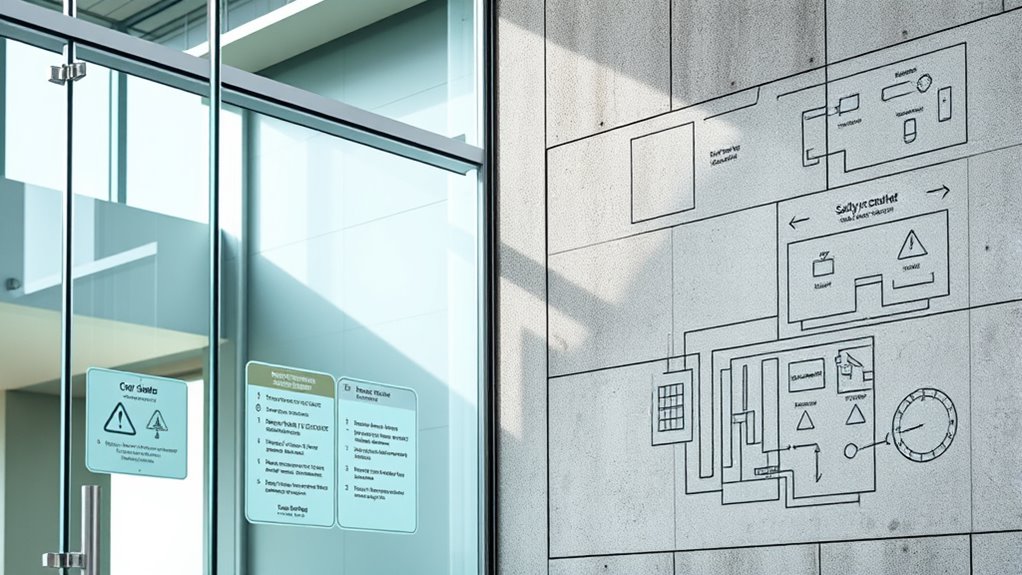
Building codes for glass and solid walls are designed to guarantee safety, durability, and structural integrity. When it comes to glass walls, these codes often specify requirements for safety glass, impact resistance, and proper installation, ensuring your space remains secure. Solid walls, meanwhile, must meet standards for load-bearing capacity and fire resistance. But beyond safety, building codes also address decorative finishes and aesthetic considerations. They set guidelines for how materials can be used to achieve your desired look without compromising safety or quality. Understanding these codes helps you make informed decisions about material selection, finishes, and design details, blending beauty with compliance. Staying within these standards ensures your project looks great and adheres to necessary regulations. Additionally, awareness of security zone info can help inform security features integrated into building design for enhanced safety.
Safety Standards for Glass Wall Installations
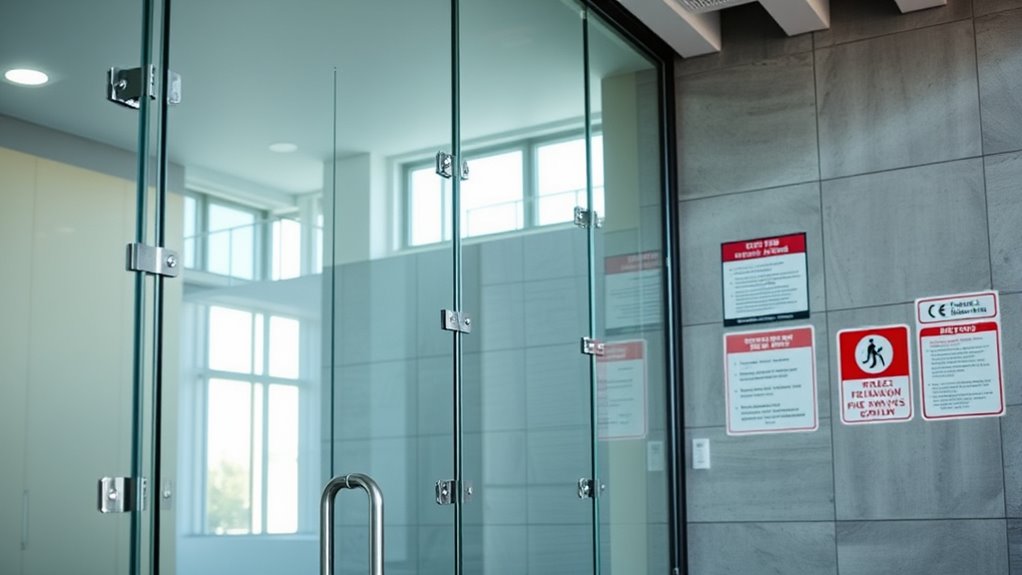
To make certain your glass wall remains safe and secure, it’s essential to adhere to specific safety standards during installation. These standards ensure the glass can withstand impacts and prevent accidents. Choose tempered or laminated glass to enhance safety, especially in high-traffic areas. Proper framing and mounting techniques are critical to support the glass’s decorative aesthetics and maintain structural integrity. Additionally, safety standards promote ideal acoustic performance by preventing sound leaks and ensuring privacy. Regular inspections and quality control measures are necessary to identify potential vulnerabilities early. Implementing AI-driven safety monitoring can further enhance ongoing compliance and early detection of issues. By following these guidelines, you’ll not only comply with building codes but also create a visually appealing space that balances style with safety. This proactive approach minimizes risks and maximizes the benefits of your glass wall installation.
Fire Regulations and Material Compliance
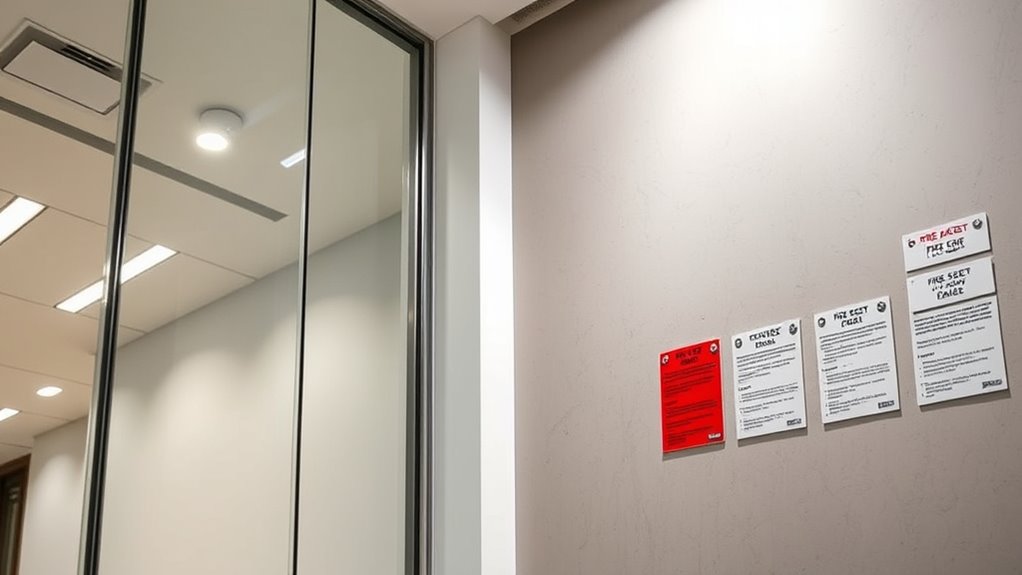
Ensuring your glass walls meet fire regulations and material compliance is essential for safety and legal adherence. You must select fire-rated glass and comply with standards that specify resistance to heat and flame. This includes considering decorative finishes, which can enhance aesthetics without compromising safety. Be aware that certain finishes or coatings might affect fire performance, so verify their compatibility with fire safety codes. Material compliance also involves choosing products with proper certifications and documentation. Aesthetic considerations should align with fire safety requirements, ensuring that visual appeal doesn’t override safety standards. By carefully selecting compliant materials and finishes, you create a space that’s both beautiful and safe, reducing risks and ensuring adherence to all relevant fire regulations. Additionally, understanding the importance of Self-Understanding can help you better evaluate the safety features needed for your project, ensuring comprehensive compliance and personal confidence in your choices.
Structural Integrity Requirements for Walls
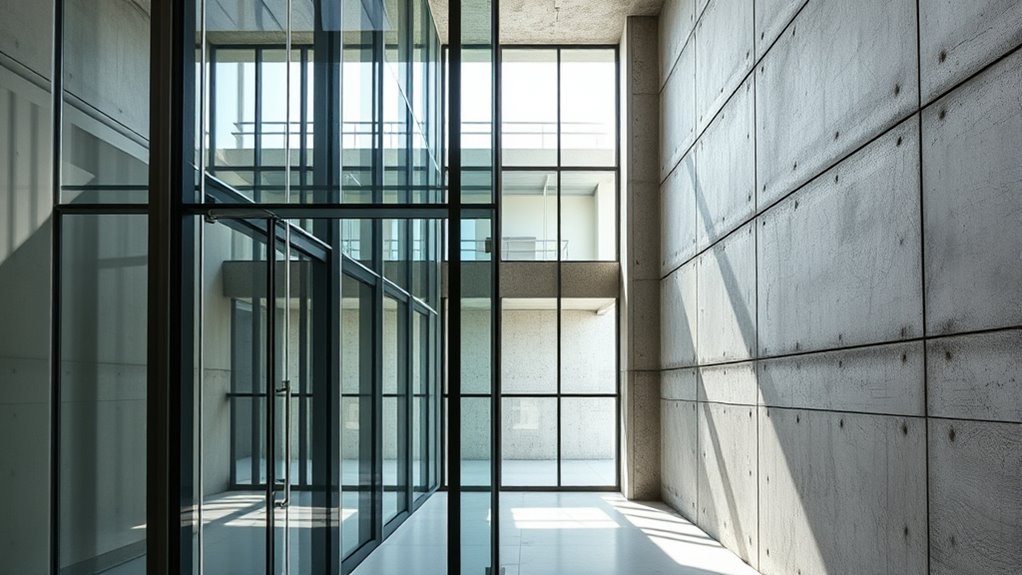
While fire safety and material compliance focus on protecting occupants from hazards, the structural integrity of your walls guarantees they can withstand loads and stresses over time. Ensuring this involves understanding key factors like material strength, load-bearing capacity, and resistance to environmental effects. Walls must handle thermal expansion without cracking or warping, especially with temperature fluctuations. Proper design also enhances acoustic insulation, reducing noise transfer. To meet these requirements, consider:
Ensuring wall stability requires understanding load capacity, material resilience, and environmental resistance for long-term safety.
- Adequate reinforcement for load support
- Materials that resist thermal expansion
- Design features for long-term stability
- Compatibility with insulation layers
- Inspection protocols for ongoing integrity
Structural integrity is also influenced by compliance with safety standards and regular maintenance to prevent damage over time.
Impact Resistance and Safety Glass Specifications

Understanding impact resistance standards helps you select the right safety glass for your needs. These classifications specify how well glass can withstand force without breaking dangerously. By knowing these specifications, you can ensure your walls meet safety codes and protect occupants effectively. Recognizing the importance of guidance and support in choosing appropriate safety measures can further enhance your safety planning.
Impact Resistance Standards
Impact resistance standards determine how well safety glass can withstand force without breaking or causing injury. These standards ensure that glass used in walls or windows meets safety requirements, balancing privacy concerns and aesthetic considerations. When choosing glass, you should consider:
- The level of impact it can resist, depending on the environment
- How well it maintains privacy without sacrificing style
- Whether it meets local building codes and safety regulations
- The durability needed for high-traffic areas
- The balance between safety and visual appeal
Adhering to impact resistance standards helps prevent accidents and injuries, especially in areas prone to accidental impacts. It also ensures your space remains safe without compromising design or privacy, making these standards essential for any glass installation. Compliance with impact resistance standards is crucial for ensuring long-term safety and durability of glass structures.
Safety Glass Classifications
Have you ever wondered how safety glass is classified based on its impact resistance? Safety glass falls into two main categories: laminated glass and tempered glass. Laminated glass consists of layers of glass bonded with an interlayer, usually polyvinyl butyral, making it resistant to shattering and preventing dangerous shards. Tempered glass is heat-treated to increase its strength, so when it breaks, it crumbles into small, blunt pieces instead of sharp shards. These classifications help determine the appropriate safety glass for different applications, ensuring compliance with building codes. Laminated glass is often used in areas requiring high impact resistance, like windshields or glass walls, while tempered glass is common in doors and shower enclosures. Understanding these classifications helps you select the right safety glass for your project. impact resistance is a key factor in determining the safety and suitability of different types of glass for specific applications.
Accessibility and Code Compliance in Wall Design

When designing walls, you need to consider ADA Accessibility Standards to ensure everyone can navigate spaces easily. You also have to meet visual transparency requirements and adhere to fire and safety regulations. These codes influence your choices between glass and solid walls to create safe, inclusive environments.
ADA Accessibility Standards
Are you aware of how ADA Accessibility Standards influence wall design in building projects? These standards ensure spaces are safe and accessible for everyone. When designing walls, consider features like proper clearance for wheelchairs, tactile indicators, and reachable controls. ADA also impacts your choices for security barriers, requiring them to be both sturdy and accessible. Soundproofing solutions are essential for maintaining privacy without blocking accessibility features. Keep in mind:
- Minimum clear widths for doorways and pathways
- Adequate maneuvering space around security barriers
- Use of non-slip, tactile surfaces
- Proper placement of grab bars and controls
- Compliance with height and reach range requirements
- Incorporating attention to detail in design can further enhance usability and safety.
Following these standards helps create inclusive environments while ensuring safety and functionality.
Visual Transparency Requirements
How do visual transparency requirements shape wall design to meet accessibility and code standards? These requirements ensure that walls, especially glass and transparent materials, allow visibility for safety and communication. They influence the choice of decorative finishes, encouraging the use of clear or semi-transparent materials that enhance aesthetic appeal without compromising safety. For solid walls, openings or glazing can provide necessary visual access while maintaining privacy and structural integrity. Meeting these standards promotes a more open environment, improves wayfinding, and supports accessibility for all users. By balancing transparency with design goals, you achieve functional spaces that are both compliant and visually appealing. Incorporating essential oils for safety can also be used to create calming environments that support well-being in spaces designed with these transparency standards in mind. This approach helps create environments that are safe, welcoming, and aligned with building codes.
Fire and Safety Regulations
Building on visual transparency standards, fire and safety regulations impose strict requirements on wall design to safeguard occupants and guarantee compliance. You must make certain that walls, whether glass or solid, meet fire ratings, proper insulation, and safe materials. These regulations also focus on accessibility and safe egress routes. When selecting decorative finishes, consider fire-resistant options that blend aesthetic integration seamlessly. Additionally, incorporating sustainable materials can enhance environmental safety and compliance.
Key points to remember:
- Use fire-rated materials for decorative finishes
- Ensure glass walls meet safety and fire codes
- Maintain clear, accessible pathways
- Incorporate safety glazing where needed
- Prioritize compliance without sacrificing aesthetic appeal
Adhering to these rules helps balance safety, accessibility, and attractive design in your wall choices.
Environmental and Sustainability Considerations
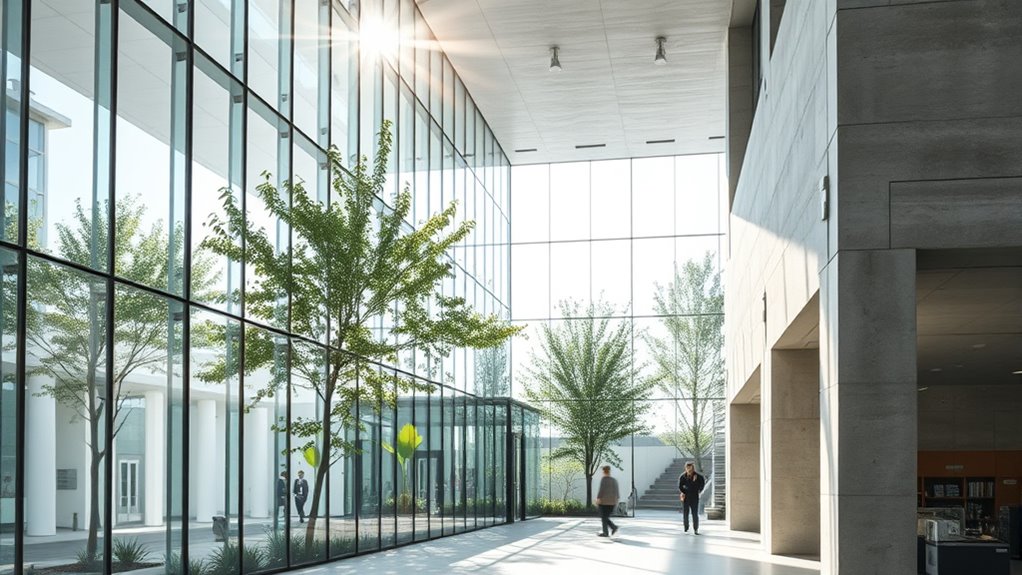
When evaluating glass versus solid walls, considering their environmental and sustainability impacts is essential. Glass walls often use sustainable materials like recycled glass, reducing the environmental footprint. They also promote energy efficiency by maximizing natural light, decreasing the need for artificial lighting. Solid walls, on the other hand, typically require more material and energy to produce, leading to higher environmental costs. Additionally, glass installations can be designed to enhance insulation and reduce heating and cooling demands, further supporting sustainability goals. Choosing between these options involves appraising how each contributes to energy conservation and resource use. By prioritizing energy efficiency and sustainable materials, you can make more eco-friendly choices that align with green building standards and long-term environmental goals.
Common Challenges and How to Address Them
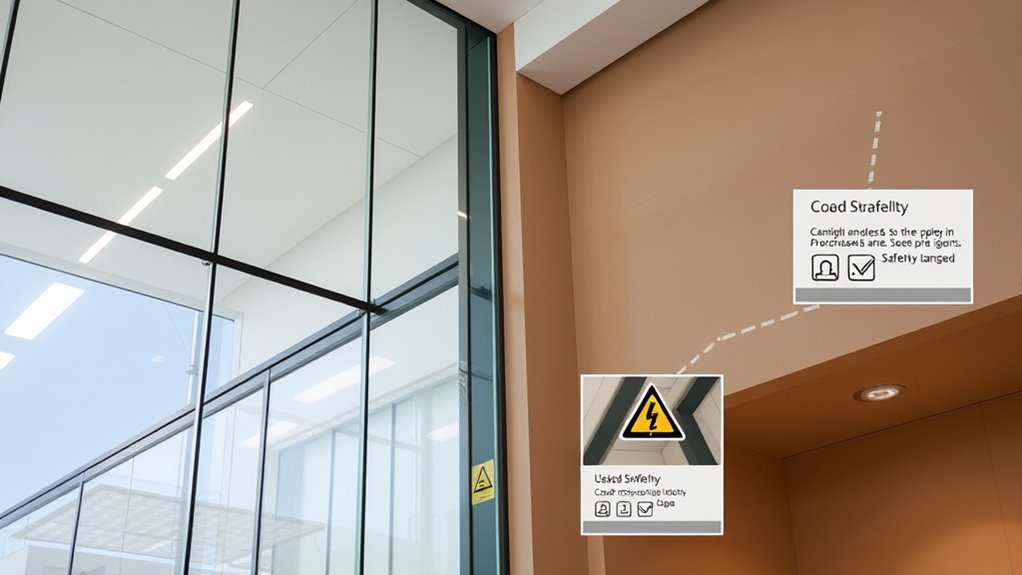
You’ll often face challenges with building code variances and ensuring your materials meet safety standards. It’s essential to stay informed about local regulations and verify compliance to avoid costly delays. Addressing these issues proactively keeps your project on track and up to code.
Navigating Building Code Variances
Understanding building code variances can be challenging because different jurisdictions often interpret and enforce standards differently. This can lead to confusion when trying to meet compliance, especially around privacy concerns and aesthetic considerations. To navigate these variances, you should:
- Review local codes early in the planning process
- Consult with building officials for clarification
- Document all communications and approvals
- Be prepared to adapt designs to meet specific requirements
- Stay updated on recent code amendments and interpretations
Ensuring Material Compliance
Ensuring material compliance can be challenging because building codes often specify detailed requirements that materials must meet, and manufacturers may not always provide clear documentation. You need to verify that materials, whether glass or solid walls, meet standards for material durability and safety. This involves reviewing testing data, certifications, and compliance reports. Sometimes, manufacturers prioritize aesthetic appeal over durability, complicating your selection process. To address these challenges, collaborate closely with suppliers to obtain thorough documentation, and conduct independent testing if necessary. Staying updated on evolving regulations helps prevent compliance issues. Ultimately, balancing material durability with aesthetic appeal ensures your project remains both compliant and visually appealing, reducing risks and boosting safety in your construction.
Inspection and Maintenance Protocols
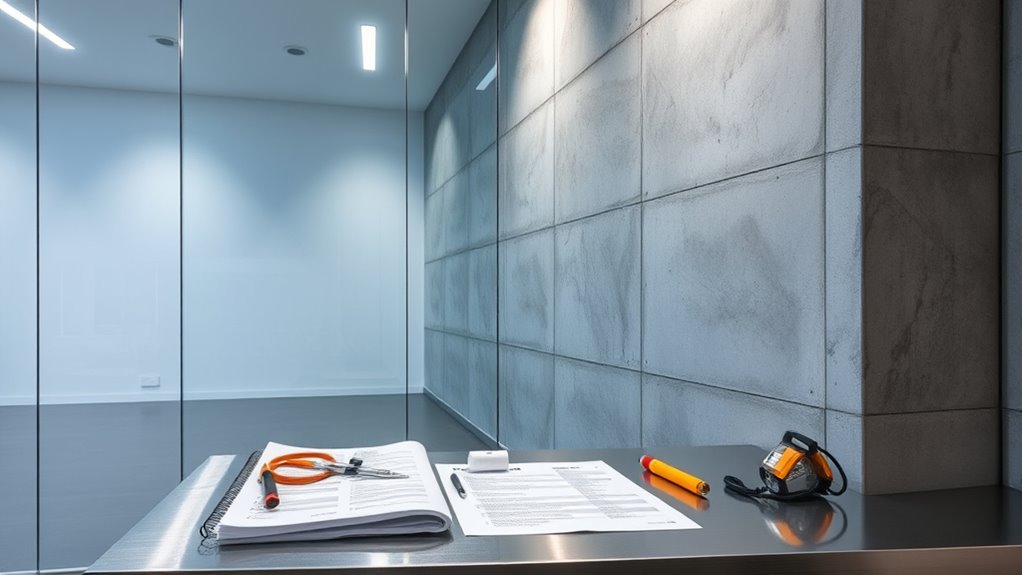
Regular inspection and maintenance are essential to guarantee the safety and integrity of both glass and solid walls. You should routinely check for cracks, chips, or damage that could compromise structural stability or safety. For walls with decorative finishes, look for peeling or deterioration that might affect aesthetic enhancements. Keep fixtures, seals, and joints in good condition to prevent leaks or instability. Clean surfaces carefully to preserve clarity and appearance. Address issues promptly to avoid escalation. Consider these maintenance tasks:
- Inspect for cracks or damage to glass or solid walls
- Check seals and joints for integrity
- Maintain decorative finishes for aesthetic purposes
- Clean surfaces regularly to prevent buildup
- Tighten or replace loose fixtures
Consistent upkeep guarantees safety, preserves appearance, and prolongs lifespan.
Tips for Ensuring Ongoing Safety and Compliance

To maintain ongoing safety and compliance, you should establish a routine schedule for inspections and updates that align with local building codes and safety standards. Regularly evaluate your glass or solid walls for structural integrity, guaranteeing decorative finishes haven’t compromised safety. Staying proactive helps you catch issues early, especially when aesthetic enhancements are involved. Use the table below to plan your maintenance:
| Task | Frequency |
|---|---|
| Inspect for cracks | Quarterly |
| Check seals & joints | Biannual |
| Review decorative finishes | Annually |
| Verify safety labels | During every inspection |
| Update compliance labels | When modifications occur |
Consistent checks assure your walls stay safe, compliant, and visually appealing.
Frequently Asked Questions
How Do Local Building Codes Vary for Glass Versus Solid Walls?
You should know that local building codes often differ for glass versus solid walls, mainly focusing on structural integrity and material durability. For glass, codes might require stronger framing and specific safety glass to prevent breakage and injury. Solid walls typically have fewer restrictions but must meet fire resistance and insulation standards. Always check your local regulations to make sure your project complies with safety and durability requirements for both materials.
What Are the Penalties for Non-Compliance With Safety Standards?
You face serious consequences if you don’t follow safety standards; it’s a case of “paying the piper.” Penalties typically include liability fines and increased insurance repercussions, which can cripple your project’s budget. Non-compliance can also lead to legal action, delays, and safety hazards. Staying compliant isn’t just best practice—it’s essential to protect your reputation and financial stability. Don’t let shortcuts come back to haunt you down the road.
Are There Specific Certification Processes for Safety Glass?
You need to guarantee your safety glass meets certification standards like ANSI Z97.1 or EN 12150, which verify its safety and performance. The process involves testing for impact resistance, shatterproof qualities, and durability. Once your glass passes these tests, it receives safety endorsements, proving it complies with safety regulations. These certifications help you avoid penalties, ensure safety, and meet building codes effectively.
How Often Should Safety Inspections Be Conducted on Walls?
An ounce of prevention is worth a pound of cure, so you should conduct safety inspections on your walls every 6 to 12 months. Regular inspection frequency helps catch issues early and guarantees your maintenance protocols stay effective. By staying proactive, you reduce risks and maintain safety standards. Make sure to document all inspections and follow recommended guidelines to keep your walls compliant and safe for everyone.
Can Existing Walls Be Retrofitted to Meet New Safety Regulations?
Yes, you can retrofit existing walls to meet new safety regulations. You should explore retrofit techniques like adding reinforcement or installing safety barriers. Material upgrades, such as replacing weaker materials with stronger, code-compliant options, also help guarantee safety. Working with professionals ensures proper installation of these upgrades, making your walls compliant and safer. Regular inspections after retrofitting will keep your walls up to code and maintain safety standards.
Conclusion
By understanding building codes, adhering to safety standards, and prioritizing regular inspections, you guarantee your walls remain safe, compliant, and sustainable. Address fire regulations, verify impact resistance, and consider environmental factors to protect everyone and preserve your space. Stay informed, stay proactive, and stay committed to safety and compliance. Doing so creates a secure environment, promotes peace of mind, and assures your walls serve their purpose effectively—today, tomorrow, and for years to come.
